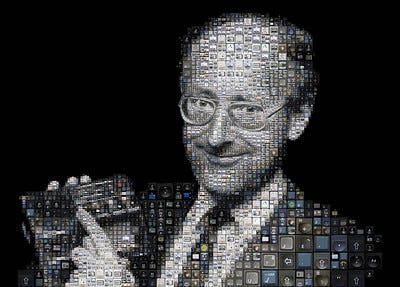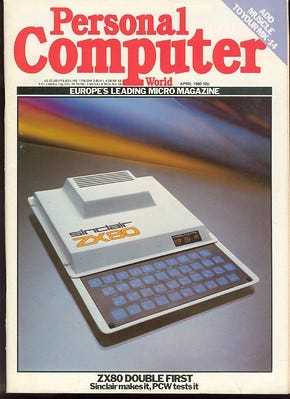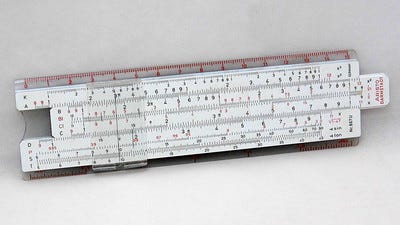
Technology-wise, we’re presently in what might be called an interregnum.
There is no clear outcome for AI, especially generative AI. We can’t tell whether it’s a saviour, a destroyer, or a damp squib. More importantly, generative AI — and a lot of other stagnant technologies — doesn’t offer a bridge between where we currently are, and where we need to go.
But what might that bridge look like?
This is best explained by looking at an earlier paradigm shift: when personal computing began the journey from a DIY hobby for (mostly) 14-year old males to being a household tool or entertainment console. In blunt terms, the computer went from being a Meccano kit on a workbench to an item of furniture in the living room. When computers started to be useful and affordable.
Here’s a great visualisation which captures this sudden growth in the early 1980s (Source: Home computer sales, 1980–93 | Retro Deam/YouTube)
(The video doesn’t include IBM-compatible PCs, which of course eventually stole most of the market for a few decades. But you get the idea.)
For the masses
Exploring why and how this shift happened might help us understand what we should be looking for right now: what engine of change should we be keeping an eye out for, or, if we were of entrepreneurial bent, cooking up in a lab somewhere?
A Canadian Holocaust survivor, Jack Tramiel, was the first to recognise that computing was as much a consumer device as a business one. The trick was to make it visually appealing, fun, and cheap. His Commodore 64, unveiled in January 1982, was the first real mass market computer, with sound, graphics and software — all for less than $600. The computer “for the masses, not the classes” took North America by storm in 1981. At the time an Apple computer, though far better, would cost at least twice that. The Commodore 64 sold upwards of 12 million units.
Tramiel had understood computers were not confined to the workplace or science. But a British entrepreneur also understood that and may, on balance have contributed more to building the bridge that connected ‘computing’ with ‘appliance’. Sinclair (later Sir Clive) had sold circuit boards and kits profitably to a market of do-it-yourself enthusiasts since the early 1960s, but he was sure there was a much bigger market if he could make the products accessible and cheap enough.

Sinclair wanted to sell them below £100 — about $200 at the time. He knew the market well — enthusiasts wanted to get their hands on one to tinker with, to write code on, to learn how the machines worked, but they were often kids, and didn’t have a lot of cash.
Crucially for bridge building, he focused on marketing and distribution.
According to Bill Nichols, who ran his PR at the time, Sinclair understood that the market itself needed to be carefully nurtured in the crucial early days. Clive “always insisted that every product first went to market mail order under the total control of the company and the marketing team.” This direct connection, via a cohort of outsourced customer service staff allowed the company to hear and respond to feedback directly from early customers. “Then and only then when the awareness and initial demand was created — typically after six months or so — did it go retail,” he told me.

“Retail” here didn’t mean hobby and computer shops but high street heavy hitters like stationery and newpapers chain WH Smith and pharmacy and healthcare giant Boots. Now the demand had been nurtured enough to be self-supporting, and Sinclair’s marketing and pricing had taken hold, retailers could be confident there was enough demand across a broad customer base to make it worth their while to display them prominently.
Tomb Raider and GTA
For kids and parents they were now easy to find, impossible to resist, and fun to use. The ZX Spectrum, the third incarnation of the Sinclair computer launched in April 1982, sold over 5 million units. Sinclair was a suddenly a serious competitor to Commodore: the Commodore sales team felt them to be enough of a threat to post a photo of Sinclair’s marketing chief Nichols on their dart board.
In one year the computer had gone from an obscure piece of machinery to a consumer device. It also played an important role in creating what we’d now call the ecosystem to support the transition. It was still a little unclear what computers might do for us. Games was the most obvious thing, and the ZX series are credited with spawning a generation of ‘bedroom coders’, kids who would develop games and sell them via hobby magazines. The British video game industry now employs over 20,000 people, and major franchises like Grand Theft Auto and Tomb Raider can trace their roots to companies founded in this early wave. By 1984 the UK had more computers per household (13%) than the U.S. (8.2%) — with the U.S. only catching up in the 2000s.
Sinclair made mistakes. A crucial one was trying to build a market with professionals with the next ZX model, the QL. The device was as half-baked as the rationale — professionals who might need a spreadsheet would already have an IBM PC — and its failure led to him selling the ZX business to a consumer electronics company, Amstrad. Amstrad’s owner, Alan Sugar, had a better instinct for what people needed a computer for: his line of PCW computers were marketed as “word processors”. He sold 8 million of them. (I was no techie but I bought one, and it kickstarted my journalism career. My dad wrote a book with it.)

Sir Clive and Jack Tramiel are mostly forgotten figures now but it’s no exaggeration to say this: he probably contributed as much as the likes of Bill Gates, Steve Wozniak and Steve Jobs to the silicon landscape we inhabit today. Both built bridges from the narrow enclaves of ‘enterprise’ and ‘hobby’computing to something called ‘personal computing’, without which we wouldn’t be writing, distributing and reading this on computing devices. In 1980 some 750,000 devices that could be called personal computers were sold. In 1990 there were 20 million. (Source)
That this period is largely forgotten is to our cost. Sure, Gates was instrumental but he was late to the game — Windows 95 was arguably its first consumer-facing product. Jobs understood the market better, but Apple’s first Macintosh, launched in 1984, cost $2,500, ten times a ZX computer. Both Microsoft and Apple scaled the divide between office and home device, but it was the Commodore, ZX, and a handful of other much cheaper devices that built the bridge between them.
Sliding the rules
So what do we learn here? What lessons can we apply to the place we’re in today?
Well, first off, we have lousy memories. That the Sinclairs of this world, and what they did, are rarely mentioned shows just how little we understand about how computing got to be the ubiquitous, ambient thing it is today.
Secondly, there’s only so much we can learn through the lens of Silicon Valley’s favourite business consultant. Superficially at least, Sinclair was an early entrepreneur in the Clayton Christensen mould: catering to underserved segments, building products that were affordable, simplified and user-friendly, and making incremental improvements to gain market share. But he was so much more.
Sinclair was obsessed by several things, one of them fatal. He understood two key concepts: price and size. While semiconductor manufacturers would discard chips that didn’t meet their specifications, many of those rejects might work fine if he designed a product to more lenient specs. “Good enough,” in Clayton Christensen’s words. For the rest of his life he would follow a similar pattern: dream up a product, scout out the technology to see whether it could be built, and then pare back the product (and the size and quality of components) to fit a specific price point and size.
Sinclair’s obsession with the miniature emerged less from notions of disruptive innovation and more, his sister Fiona believes, from the “very confused childhood” they shared, which led her to therapy and him to seeking to impose order on the world. “Everything he makes, everything he designs is to do with order — making things smaller, finer, neater,” she said of him.
The resulting products all leveraged technology to build bridges from niche market to mass. His calculators were small and stylish enough to be desirable in a way calculators hadn’t been before, but cheap enough for everyone. It’s hard to overstate the impact this had. Schoolkids like me were still being taught how to use a sliderule to make calculations in the 1970s, but when the first kid brought a Sinclair Oxford 100 into class (£13) we knew those log table books were doomed.

But he had another infatuation: the new. The Sinclair QL, which effectively killed his computer business, arose out of his reluctance to build on a good thing, throwing the earlier ZX model out and trying something completely new, for a market that was already being catered to and which didn’t care overly about price. Launched in 1984, the QL was discontinued within two years after selling around 150,000 units, and Sinclair was forced to sell.
Sinclair understood about the bridge, but in this case misread it. The bridge here was a bridge backwards, returning to a market that already existed, and where users weren’t overly sensitive to price, but were sensitive about usability.
A calculator in your stocking
To me the key lesson to be drawn is this: Sometimes there needs to be an intermediary technology, or technologies, that can be pulled together in a new (and cheaper) way to create a new device, possibly even one that doesn’t have a name. There may be no demand for such a device, but that demand can, with good marketing and distribution, be created. By doing so you create a new market beyond the old one.
This might sound easy and obvious, but it’s not. Sinclair was already well-versed in this approach before he applied it to computers. He had built tiny transistor radios, taking the radio out of the living room and into the pocket or bedroom; home-made amplifiers to take hifi away from the deep-pocketed connoisseur; calculators out of science labs and accounting departments; digital display watches light years ahead of your smart watch; and (spectacularly, in terms of grand failures) electrical vehicles out of the auto industry and milk float sector.
Not all of these, ok not many of these, were successful, but it helped Sinclair develop a good understanding, not so much of invading existing markets a la Christensen, but of creating new ones. No one realistically thought that everyone wanted a calculator until Sinclair suggested it would make a great Christmas present. No one thought a computer would be much fun until he got them into stationers, toy shops and pharmacies. He built a bridge to a place no-one thought existed.

We are in something similar now. We have been sitting on a plateau of new, technology-driven consumer products for nigh on a decade now. Interesting technology — materials, blockchain, AI, AR, VR — hasn’t created any real mass market, and that, I believe, is in part due to a lack of imagination and understanding of how bridge-building to new markets works.
I don’t claim to know exactly where those new places are. It could be that some part of AI makes it possible for us to develop a taste for always-new music, say: so instead of us seeking out the familiar when it comes to aural entertainment, we demand AI creates something new for us. (I’ve mentioned before how intriguing I find the likes of udio.com. Here’s a rough stab at “a song in the style of early Yellow Magic Orchestra” with abject apologies to the souls of Yukihiro Takahashi and Ryuichi Sakamoto. )
This is probably too obvious and too narrow an assessment of the market’s potential. Sinclair’s advantage was that he was a nerd first, but a consumer a close second. He dreamed of things he’d like, he understood the technologies, their availability or lack of it, and he cared deeply about form factor. He brought disparate software, materials, circuitry and functionality together to make something that people either never thought they needed, or never imagined they could afford.
Others took his ideas and made them better, cheaper, more reliable: Casio’s calculators (and calculator watches); Amstrad’s computers; even his C5 electric trike, which I’ll explore more deeply elsewhere, became the opening salvo in a decades-long struggle that brought us EV scooters, even the Tesla.
It takes an uncommon mind to see these markets and build the bridges between them. We would not be here if it weren’t for folks like Sinclair who felt people would like these technologies if they were cheap enough, and fun enough, and he understood, at least a little, where we might go with them if we had them.
Now it’s time for someone to ask the same questions and build us some bridges from where we are — computing devices that have been good enough for a decade, software that is mostly a retread of last year’s, and an AI that is undoubtedly impressive, but also depressingly flawed and ultimately dissatisfying.
Over to you.